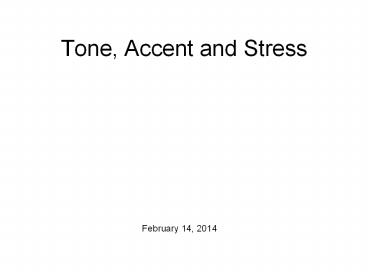Tone, Accent and Stress - PowerPoint PPT Presentation
1 / 23
Title:
Tone, Accent and Stress
Description:
Japanese is a pitch accent language for some, but not all, words for some, ... Syllable Structure and Stress Author: Stephen Winters Last modified by: – PowerPoint PPT presentation
Number of Views:196
Avg rating:3.0/5.0
Title: Tone, Accent and Stress
1
Tone, Accent and Stress
February 14, 2014
2
Practicalities
- Production Exercise 2 is due at 5 pm today!
- For Monday after the break Yoruba tone
transcription mystery tone language exercise. - Mid-term is on the Friday after the break.
- I have a mid-term review sheet for you!
- Also I have your last transcription homeworks.
- Ive also posted a practice transcription
exercise for you on the class web page.
3
Pitch Tracks
- Measuring the fundamental frequency (F0) at
every step in a sound file yields a pitch track. - Time on the x-axis.
- Fundamental frequency on the y-axis.
F0
time
Id like to collect sea shells this
after noon
4
Just So You Know
- Praat has an automatic pitch tracker.
- Check it out.
- It can be messed up by
- voiceless sounds
- obstruents (stops, fricatives, affricates)
- Also, it can sometimes double or halve the
correct fundamental frequency. - Ill spare you the technical reasons why.
- In general, though, it works well.
5
Tone
- Tone is the linguistic use of fundamental
frequency to signal important differences in
meaning. - Note
- Acoustic Fundamental Frequency
- Perceptual Pitch
- Linguistic Tone
- English is a tone language
- Sort of. For one set of words only.
6
A Typology
- F0 generally varies in three different ways in
language - 1. Tone languages (Chinese, Navajo, Igbo)
- Lexically determined tone on every syllable or
word - 2. Accentual languages (Japanese, Swedish)
- The location of an accent in a particular word is
lexically marked. - 3. Stress languages (English, Russian)
- Its complicated.
7
Mandarin Tone
- Mandarin (Chinese) is a classic example of a
tone language.
ma1 mother ma2 hemp ma3 horse ma4 to scold
8
Mandarin Sentences
ma1-ma0 ma4 ma3. Mother scolds the horse.
ma3 ma4 ma1-ma0. The horse scolds mother.
9
How to Transcribe Tone
- Tones are defined by the pattern they make
through a speakers frequency range. - The frequency range is usually assumed to
encompass five levels (1-5). - (although this can vary, depending on the
language)
5
Highest F0
4
3
2
Lowest F0
1
10
Tone 1 2 3 4
- In Mandarin, tones span a frequency range of 1-5
- Each tone is denoted by its (numerical) path
through the frequency range - Each syllable can also be labeled with a tone
number (e.g., ma1, ma2, ma3, ma4)
11
How to Transcribe Tone
- Tone is relative
- i.e., not absolute
- Each speaker has a unique frequency range. For
example
Female
Male
5
Highest F0
200 Hz
350 Hz
4
3
2
Lowest F0
100 Hz
150 Hz
1
12
Relativity, in Reality
- The same tones may be denoted by completely
different frequencies, depending on the speaker. - ?Tone is an abstract linguistic unit.
female speaker
ma, tone 1 (55)
male speaker
13
How To Transcribe Tone
female speaker
ma, tone 4 (51)
male speaker
Some speakers also use more of their frequency
range.
14
Even More Tones
level tones
contour tones
15
Variations
- Other tone languages only have two or three tone
targets - These are transcribed as sequences of High (H)
and Low (L) tones. (or also Mid (M) tones) - They can also be labeled with accents over
vowels - High
- Low
- In these languages, tone can be used for
grammatical markers (tense, possession)
16
Ibibio Tones
- Ibibio is spoken in southern Nigeria
17
Accentual Languages
- In accentual languages, there is only one pitch
accent associated with each word. - The pitch accent is realized on only one
syllable in the word. - The other syllables in the word can have no
accent. - Accent is lexically determined, so there can be
minimal pairs. - Japanese is a pitch accent language
- for some, but not all, words
- for some, but not all, dialects
18
Japanese
- Japanese words have one High accent
- it attaches to one mora in the word
- A mora a vowel, or a consonant following a
vowel, within a syllable. - For example
- ni two has one mora.
- san three has two morae.
- The first mora, if not accented, has a Low F0.
- Morae following the accent have Low F0.
Its actually slightly more complicated than
this for more info, see http//sp.cis.iwate-u.ac
.jp/sp/lesson/j/doc/accent.html
19
Japanese Examples
- asa morning H-L
- asa hemp L-H
20
- chopsticks H-L-L
- bridge L-H-L
- edge L-H-H
21
Length Distinctions
- Another suprasegmental linguistic feature is
quantity. - Note
- Quantity Linguistic
- Length Perceptual
- Duration Acoustic
- Quantity distinctions are also relative.
- depend on speaker
- depend on speaking rate
22
Danish Vowels
23
150 milliseconds
275 milliseconds
- Differences in quantity between segments
translates to relative differences in duration.































